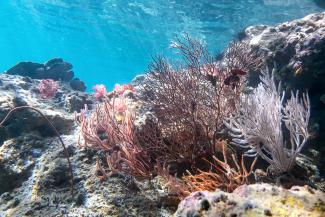It is therefore not surprising that microalgae are used in the production of food, animal feed, fertilizers and high-quality bio-based products. They are ingredients of products, such as biofuels, natural dyes, preparations for skin rebuilding and scar healing, and powdered microalgae with exceptional nutritional values perfectly supplement the food.
A small vial of microalgae costs around PLN 100 - after all, we are talking about the raw material obtained from sea water, which covers over 70% of the earth's surface. What's the problem?
Dedicated microalgae cultures are expensive, collecting microscopic cells from tonnes of salt water is like looking for a needle in a haystack. The filtration process is multi-stage and costly, and usually includes preliminary filtration, centrifugation and drying. It is performed once on a constant volume of water and it only makes sense if we know that the concentration of microalgae is very high.
Is the breakthrough coming? In 2016, Brian Miller (University of Edinburgh) published in "Nature" article devoted to the so-called microfluidics. It turned out that microchannels with a specific geometry allow the separation of fine particles, and thus microalgae. He constructed a device that was a kind of labyrinth with one inlet and two outlets.
- Outlet A is "accessible" to water only. Particles cannot come out through it. This means that the water coming out of outlet A no longer contains algae and can be drained from the system.
- Outlet B is accessible to water and microalgae. However, since some of the water was discharged at outlet "A", the concentration of microalgae is higher here than at the inlet. The mixture can be drained for subsequent filtration until the desired concentration of microalgae in the water is obtained.
The presented solution makes it possible to replace the previously used multi-stage process with one that operates in a continuous mode. So it is very possible that we are approaching the moment when microalgae will be widely available at a much lower price.
In order to commercialize the results of their research, Brian Miller and Monika Tomecka founded the Scottish-Polish startup uFraction8. In order for the filtering station to achieve parameters that guarantee the profitability of the solution, it is necessary to properly connect several dozen or even one hundred filter modules operating according to the previously described and patented solution.
The role of Lodz University of Technology
This is where the role of Lodz University of Technology begins. Scientists from the Institute of Turbomachinery (a team led by Dr hab. inż. Aleksander Olczyk, Dr hab. inż. Krzysztof Sobczak, and the author) will co-create a flow system connecting filter modules.
For this, we must first understand well how each of them works. We will conduct comprehensive tests of a single module and obtain its characteristics and determine the conditions under which filtration is most effective. Thanks to this knowledge, it will be possible to carry out further research and design work aimed at appropriate shaping of the flow channels. The ideal shape of the channel is one in which each filter works in the optimal range. It's a bit like tuning instruments for a 100-person orchestra.
The project is interdisciplinary and requires the participation of specialists from many areas. Dr hab. inż. Krzysztof Sobczak will conduct numerical research, and the experimental work will be supervised by Dr hab. inż. Alexander Olczyk. Measurement of the concentration level of microparticles in the suspension will be possible due to the collaboration with the X-ray Crystallography and Crystallochemistry team of the Faculty of Chemistry.
If the assumed goals are achieved, microalgae will soon cease to be an exclusive good. The cost of obtaining them will drop significantly and we will all be able to use natural products based on microalgae.


